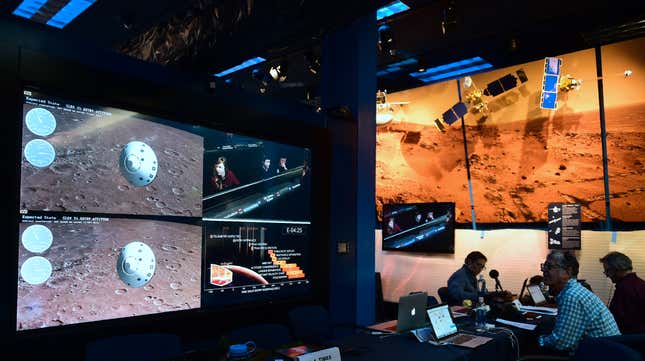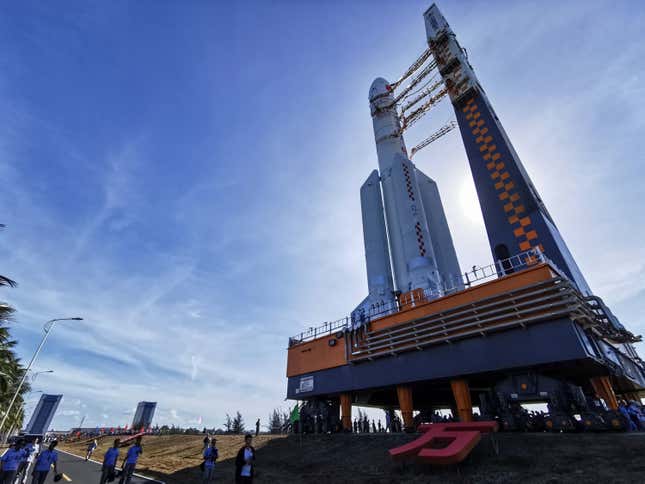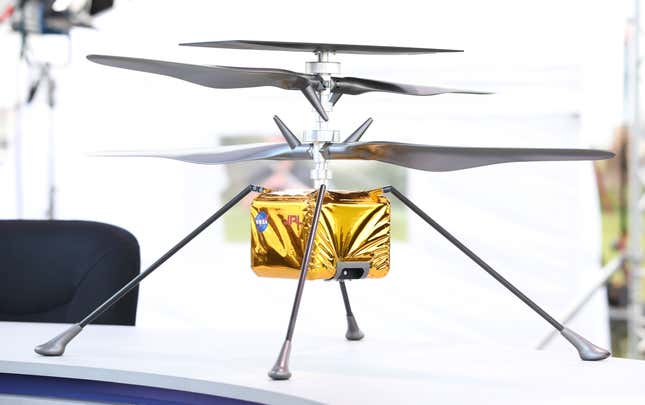
Both China and the United Arab Emirates reached Mars orbit this week in what promises to be a fascinating month for space exploration. And NASA will be landing on the Red Planet next week.
It seems Mars is the place to be right now.
That’s because Mars is fairly close to the Earth right now. It actually reached the closest point to Earth just this past October, when Mars was only 38,568,816 miles (62,070,493 kilometers) away, according to Space.com. Space-exploring countries would have to wait another 15 years for Mars to reach this spot in space again, or another two years to get a straight shot at Mars. These three missions were already well on their way to Mars back in October. There’s an 11-minute radio lag between planets, so each of these missions has been something of a nail-biter.
What are China, the UAE and the U.S. doing up there? Here’s a brief rundown of the various Mars missions from around the world:
China

China’s Tianwen-1 spacecraft (Tianwen means “Questions to Heaven,” and comes from a poem written by the ancient Chinese poet Qu Yuan) and includes an orbiter, a lander and a rover. China successfully entered Mars’ orbit on Wednesday, but the lander and rover won’t make contact with the rust-colored soil of Mars until sometime this spring. Like the UAE’s probe, the Tianwen-1 performed a 14-minute braking maneuver in order to snag the Martian atmosphere.
China’s rovers resemble NASA’s Spirit and Opportunity rovers, BBC reports, and the Chinese mission takes many cues from previous U.S. trips there. Scientists hope to use ground-penetrating radar to investigate geological layers at a depth of 10 meters. While the rover is doing that, the orbiter will also be collecting data above Mars.
Although this is the country’s first trip to Mars, China has had several wins in space recently. It’s been to the moon three times, and the Chang’e-5 mission even made it back from the Moon last December with plenty of rocks in tow — the first time any nation has achieved such a feat since 1976, according to the magazine Science.
UAE

The UAE’s probe is called Hope, and as the country’s first interplanetary expedition since getting into the space game a decade ago, a whole lot of hope is riding on this mission. This makes the UAE the first Arab nation to reach a new planet, and only the fifth country in all to do so (after NASA, the Soviet Union, the European Space Agency and India), according to the BBC. On Tuesday, Hope passed the most dangerous portion of the journey it set out on seven months ago. It needed to throw on its brakes (in the form of a 27-minute rocket burn) in order to be captured by Mars’ gravity and avoid being flung into deep space. That maneuver went splendidly.
The UAE won’t be touching down on Mars. Instead, Hope has been programmed with a novel orbit that will let it trace how energy moves through the atmosphere of the entire planet. Why is the UAE focusing on the atmosphere while the U.S. and China play battle bots on the planet’s surface? It’s all about the dust in the wind, according to the BBC:
A key influencer in this respect is dust which can on occasions blow up into storms that envelop the entire planet.
“Dust plays a hugely important role in the Martian atmosphere. There are a few places on Earth where the atmosphere can be that dusty, but they’re localised and maybe for short times,” explained Prof David Brain, a University of Colorado at Boulder planetary expert who is working with the UAE team.
“Dust absorbs a lot of energy; it can become very warm and radiate energy. And so when you’re talking about energy transport, dust is a much larger part of the big picture at Mars.”
U.S.A.

The latest U.S. mission is scheduled to touch down on Feb. 18, but the U.S. is no Johnny-come-lately to the Mars party. NASA was rolling around the Red Planet way back in 2004 with the beloved rovers Spirit and Opportunity landing on opposite sides of the planet. The plucky little machines were designed for a 90-day mission, but both far exceeded their sell-by dates. Spirit lasted 20 times longer than its original design, until its final communication to Earth on March 22, 2010, according to NASA. Opportunity made it all the way to 2018.
While all missions to space are, by definition, totally rad and bitchin’, this February’s landing is particularly cool because NASA is sending up Ingenuity — a helicopter designed to fly in the incredibly thin Martian atmosphere. It will be the first aircraft to attempt controlled flight from another planet. Its two rotors spin in opposite directions at around 2,400 rpm – many times faster than a passenger helicopter on Earth. It has to if it’s going to generate any lift on a planet that has 99 percent less atmosphere than Earth.
Ingenuity doesn’t carry any scientific instruments itself. Instead, the entire helicopter is the experiment. From NASA:
Ingenuity is intended to demonstrate technologies needed for flying in the Martian atmosphere. If successful, these technologies could enable other advanced robotic flying vehicles that might be included in future robotic and human missions to Mars. They could offer a unique viewpoint not provided by current orbiters high overhead or by rovers and landers on the ground, provide high-definition images and reconnaissance for robots or humans, and enable access to terrain that is difficult for rovers to reach.
“The Ingenuity team has done everything to test the helicopter on Earth, and we are looking forward to flying our experiment in the real environment at Mars,” said MiMi Aung, Ingenuity’s project manager at JPL. “We’ll be learning all along the way, and it will be the ultimate reward for our team to be able to add another dimension to the way we explore other worlds in the future.”
NASA is also sending up a new rover — Perseverance. But just because we’ve been on the planet before doesn’t mean things will go smoothly.
“Landing on Mars is hard,” NASA said in a detailed account of how scientists hope the mission will play out. “Only about 40 percent of the missions ever sent to Mars – by any space agency - have been successful. Hundreds of things have to go just right during this nail-biting drop.”
This may explain why NASA calls the craft’s descent and landing on the planet “seven minutes of terror.” It doesn’t help that there is an 11-minute delay between radio signals from Mars to Earth so all of the complex maneuvers by the spacecraft have to be fully automated.
Perseverance will continue NASA’s hunt for proof of ancient life and more liquid water on Mars.